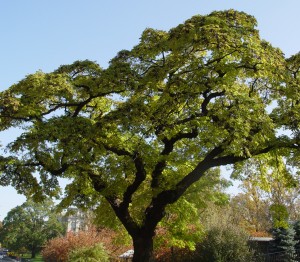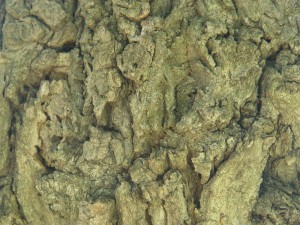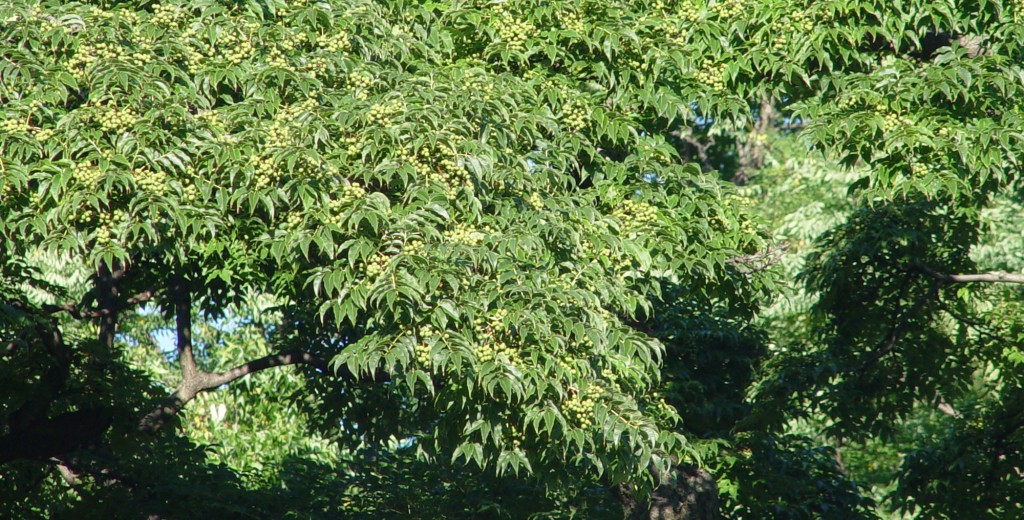Invasion of a New England Forest
Posted in Learning Experiences, Science on February 7 2012, by Sonia Uyterhoeven
Sonia Uyterhoeven is the NYBG’s Gardener for Public Education.

We have a strong science department at The New York Botanical Garden. Botanists of all backgrounds come here to work on topics that span each corner of the discipline, from ethnobotany to plant genomics. The scientists host Friday lectures where members of their staff or researchers from the wider community come to give presentations of their work. During the quiet winter months, I sometimes have the luxury of attending these seminars.
A few weeks ago, I attended a seminar on invasive plants. Invasive plants are an important topic for anyone who is interested in the environment and their community. With over $120 billion being spent annually on removal of invasive weeds (whether in the realm of agriculture, roadside maintenance, or habitat restoration), invasive plants are a very real problem. I always hear about it from the standpoint of a gardener and an educator. It was interesting for me to hear it from the perspective of a botanist and an ecologist. Not surprisingly, many of the warnings, lessons and take home messages were the same.
As the speaking botanist, Eric Morgan’s aim was to document the flora in a woodland area in southern Connecticut, analyzing the forest type and the impact of an invasion by an exotic species, the Amur cork tree (Phellodendron amurense). Morgan was interested in seeing if there was a pattern to the invasion that would help us understand overall growth patterns and predict an invasive species’ spread to other areas.
Scientists are all about data–not exclusively, of course, but collecting quantifiable data is an integral part of their research process. Morgan broke his research site down into 63 10-by-10 meter quadrats to achieve this.
He began his research by surveying the site and making a record of each species present, documenting the diversity of the woodland. He also recorded the size of the trees by measuring their DBH (diameter at breast height). He discovered that more than one in four species were invasive in his research area; the Amur cork tree ranked 14th in its prevalence and was on the rise.

Morgan extended his research to cover several other woodland sites in adjacent states to see how a variety of ecosystems were affected by this invasive introduction. The dominant species in the Connecticut forest were oaks and American beeches. Other woodland areas that he mapped were dominated by red maples and black cherry.
His research revealed that the native composition of species doesn’t matter. The Amur cork tree is an opportunist. It is capable of growing in sun and shade, wet or dry. Whenever space opens up in the canopy, the invader rushes in to fill up the space. Once established, other Amur cork trees cluster around the original specimen and colonize the area. In this way the Amur cork tree is spreading rapidly through the forest.
Another reason why the Amur cork tree is on the rise is because it is not being targeted by foraging deer. While deer will occasionally browse on this exotic species, they generally prefer native species. The only native tree that Morgan observed to be on the increase in the New England woodland areas is the American beech, which is actually deer resistant and has a suckering habit.
Morgan carried out research on the effect the Amur cork tree has on the forest’s understory planting, as well. He found that fewer native plants grow underneath the Amur cork tree than under native trees. Initially he thought it might be an issue with the amount of light that is reaching the forest floor, but found through a study of light levels that this is not the case. The same levels of light are penetrating down under the Amur cork tree as with the native counterparts. Something other than light levels is causing the relative lack of native understory plants. From here, Morgan plans to pursue the possibility of some sort of allelopathy (production of a growth-affecting biochemical) occurring around the tree that is inhibiting the growth of other species.
The Amur cork tree, like many invasive species, was originally brought over as an ornamental tree. The problem with many exotic introductions is that sometimes there is a lag time before people realize that it is invasive. Gardeners are often attracted to exotic species because of their ornamental qualities and the fact that they are sometimes immune to local pests and diseases. While this has its advantages, it can lead in many instances to larger problems. There is no natural system in place to keep it in check.
As a dioecious species, the Amur cork tree produces only male or female flowers that are found on separate plants. Since the seeds on this tree are dispersed primarily by robins that feed on the fruit, a solution may be to ensure that only male trees are sold or planted. This, however, is not reliable. It has been observed that these trees often have the ability to alter their sex (it’s not uncommon in woody plants). It is also sometimes difficult to tell whether you are buying a male or female of a certain species. They are commonly mislabeled in the nursery. We know this from the ginkgo that is a popular street tree in New York City: the males are wonderful while the females produce a fruit-like structure with an odor that will make your stomach turn.

Invasive plants are an issue that has rightly captured the attention of botanists and horticulturists alike. Exotics can come in and take over an environment, driving native species into obscurity, damaging the ecological balance, and changing a diverse flora into a barren monoculture. The message that I generally hear from spokespersons and concerned parties is to be persistent in tackling the problem through slow removal of the exotic invader, and then–equally important–to make sure to replant the disturbed space with natives to encourage the rejuvenation of the natural habitat.
At The New York Botanical Garden we are restoring our native forest by cutting down Amur cork trees, weeding out unwanted seedlings, and replanting the area with native trees and understory plants. Since we are working in a large area and in a challenging woodland environment, we are not planting conventional, pampered nursery plants that have been heavily fertilized and grown in large pots. We are planting plugs, or small, three-inch containers that have been grown lean so they can be planted, watered, and left to fend for themselves.
A final point that is worth mentioning is that most states have lists of invasive plants available to the public. Some states such as Arizona and Florida are ahead of the game with strict regulations on the sale or introduction of non-native species. Other states have recommendations on what nurseries should avoid growing and selling. However, these recommendations are seldom enforced, and it is up to the public to inform themselves and pressure the industry not to sell plants that may create problems in terms of habitat destruction.
Responsible gardening is the first step in the battle against invasive exotics. Promoting interest in the removal of invasive plants to community groups that can go out and tackle problem areas is equally important. Groups like the Boy Scouts/Girl Scouts, sports teams that participate in community service days, church groups, and recent retirees who are looking for activities are good places to start.

